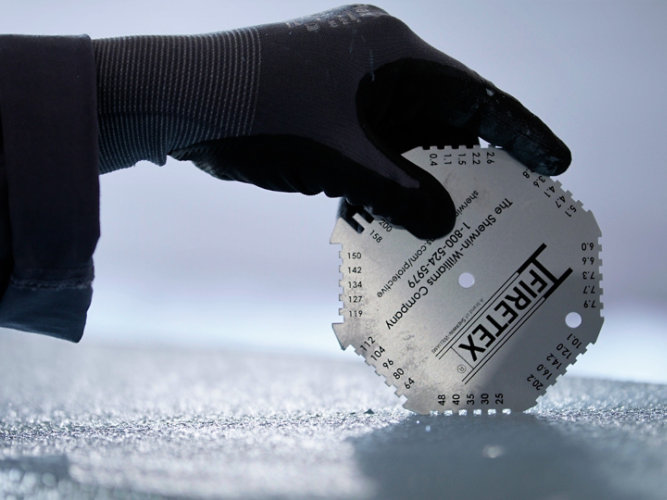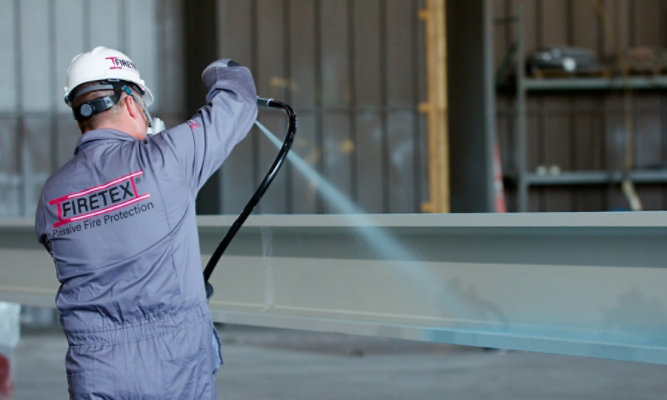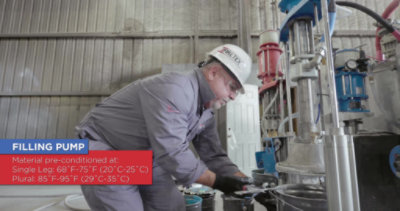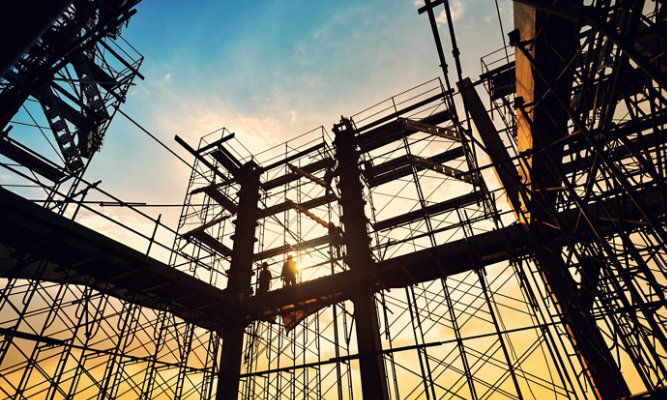Simplifying Project Sequencing for Faster, Safer Electric Vehicle Battery Plant Construction
How Offsite Fireproofing Applications Enable Better Project Outcomes
by Joseph Windover, Construction Executive, and Jacob Allard, Construction Executive, Sherwin-Williams Construction Solutions
Contact us for more information

With electric vehicles (EVs) poised to reach 40% to 50% of car sales in the United States by 2030, surrounding infrastructure is being built at a rapid pace to support this burgeoning demand.1,2 That includes numerous production facilities for manufacturing the battery cells that power EVs. Popping up rapidly across the country, these plants have unique requirements for the original equipment manufacturers (OEMs), joint ventures and independent operators constructing them.
Typical EV battery cell production facilities consist of large industrial buildings housing areas for raw material storage, wet processing, production, assembly and distribution. Several of these areas are cleanroom-level environments that require high filtration, very low humidity and specialized flooring to dissipate electrostatic charges. In addition, the facilities must be fireproofed given that they house extremely flammable and explosive materials. These requirements make the overall construction of an EV battery plant significantly more complex than building a typical automotive plant. Adding to the challenge, market demands are creating substantial pressure to build these massive buildings faster.
Fortunately for facility owners, notable efficiencies can be gained in the early stages of construction to make the entire process less cumbersome. Of particular note is a major adjustment to project sequencing that results from moving the traditional fireproofing process away from the construction site to an offsite coatings shop. Doing so can greatly simplify construction scheduling, keeping typical construction site interruptions for fireproofing to a minimum and accelerating fireproofing completions. This simpler approach is a catalyst that enables safer, faster and better outcomes for constructing EV battery plants. As a bonus, it also offers significant potential cost savings between $900,000 and $4.4 million for a typical facility, depending on which traditional onsite fireproofing method it replaces. Let’s review how.
Simpler Project Sequencing
To demonstrate the benefits of shop-applied fireproofing applications, we’ll use the example of a new one million ft2 EV battery plant being constructed that requires 100,000 ft2 of structural steel surface area to be fireproofed. When and where the fireproofing is performed will be a key factor in simplifying processes and therefore enabling the project to be done safer, faster and better.
The type of fireproofing material used also matters, as the application of liquid Intumescent Fire-Resistive Materials (IFRMs) is far simpler than applying traditional cementitious coatings and cleaning up any excess material afterwards. Also known as Sprayed Fire-Resistive Materials (SFRMs), cementitious fireproofing coatings are sprayed onto structural steel surfaces as wet cement, which then cures and adheres to the steel. The process is nearly always performed onsite, and it is messy, with cement overspray hitting areas that aren’t meant to be coated and clumps of excess material falling to the floor. IFRMs, which are typically thin-film epoxy coatings, are less cumbersome to apply, whether doing so onsite or at an offsite facility. Applicators must spray a sufficient film build of the liquid epoxies onto steel surfaces, perhaps making multiple passes to reach the thickness required for the building’s specified fire protection rating (Figure 1).
Dramatic project sequencing differences exist between the fireproofing methods, with offsite IFRM applications greatly reducing the number of constraints on other trades working at the construction site compared to when applicators use IFRMs or SFRMs onsite.
IFRMs or SFRMs Applied Onsite
In traditional construction projects, fireproofing materials are typically applied onsite despite the inherent inefficiencies. Some applications may take place in a makeshift, semi-controlled tented area before the steel is erected, but, more likely, the steel will be erected as it arrives to the construction site, and applicators will then fireproof the steel after it has been bolted into place. In either scenario, the fireproofing activities create project sequencing challenges that result in several stops and starts for various trades. When applicators are spraying IFRMs or SFRMs, other trades are unable to work in that area, as any dust and debris stirred up could affect the adhesion of the coatings. Plus, other workers would be subject to the potential of being hit by fireproofing material overspray as applicators coat the steel.
During each of those delays for fireproofing, applicators will need to set up containment tarps and enclose the areas being coated. These enclosures prevent debris from surface preparation activities and overspray from fireproofing applications from infiltrating other areas of the construction site. This protection also allows other trades to continue working on other areas of the structure. But it takes precious time to cordon off large areas, complete surface preparation and coat the steel – during which no other activities will likely take place in those areas. In addition, the enclosed areas may need to be conditioned to bring temperatures and the relative humidity to suitable levels for the sprayed material to adhere and cure. Such requirements add time, cost and complexity to the job.
IFRMs Applied in a Shop
Managing the fireproofing process using IFRMs in a shop environment makes project scheduling simpler. Applications can be completed before any steel erection takes place at the job site, or even during the erection process, with deliveries of fireproofed steel timed to align with the project’s current progress. Performing the fireproofing applications offsite and before the steel is erected greatly reduces common constraints associated with onsite coating applications. Various other trades, including electricians, plumbers, concrete installers and others, can freely go about their business during the steel erection phase without the otherwise frequent need to coordinate with coatings applicators and stop work during onsite fireproofing activities.
There is only one brief constraint period in this scenario, covering the time during which applicators onsite will need to complete the final IFRM applications on the erected steel. At the shop, applicators will coat approximately 80% of the entire surface area of the structural steel for the building. The remaining 20% represents “hold back” areas that will need to be fireproofed after the steel is bolted together (Figure 2). These areas will receive a primer coat to prevent the steel from flash rusting, but they’ll be left free of IFRMs, as the intumescent coatings should not be applied in between fastened metal pieces since they’re designed to swell in a fire. Onsite, applicators will need to apply IFRMs to every hold back area at the same thickness that was applied in the shop, perhaps setting up small containment structures around the areas and preparing the steel surface as needed. They can perform this final touchup-level activity somewhat strategically in the project sequence timeline to minimize the number of trades affected in a given area.
With nearly all constraints removed from the process by applying IFRMs in the shop, scheduling becomes simpler at the construction site. In addition, the process eliminates the need for most, if not all, tarping, as well as the use of heating and/or dehumidification equipment. Onsite traffic, logistics and storage are also simplified, as fully coated steel pieces can be pulled directly from delivery trucks and installed rapidly into the structure (Figure 3). In addition, cleanup is much easier, as there is no SFRM-related mess to remove.
Faster Project Completions
The simplified nature of applying IFRMs in a shop environment enables major efficiencies compared to applying either IFRMs or SFRMs at the construction site.
Inside the controlled coatings application shop environment, IFRM applications can go much faster than at the construction site. A shop is essentially a factory, built specifically to move uncoated steel through various processes to deliver a consistent, quality finish that meets specifications. Each task is choreographed and optimized for throughput. At the construction site, it’s hard to achieve application consistency. Construction delays, weather conditions, other trades working and additional obstacles threaten efficiency. And, as previously established, other workers will need to clear the area where onsite IFRM or SFRM applications are taking place, slowing building progress.
The disruptions and delays for other trades noted in the project sequencing discussion are true regardless of whether workers are applying IFRMs or SFRMs. However, IFRMs offer significant time savings, as the entire 100,000 ft2 of steel surface area from the facility example can be fireproofed in half the time when spraying IFRMs in a shop and completing touchups onsite (45 days) compared to applying SFRMs onsite (90 days). Alternatively, applications can be done 30 days sooner when spraying IFRMs onsite (60 days) compared to applying SFRMs onsite (see Table 1 below). With coatings applications completed sooner, entire buildings can be finished faster as any trades that are dependent on fireproofing completions can start their tasks sooner.
Finally, IFRMs enable faster installations of various items that may be attached to fireproofed structural steel, such as ductwork, plumbing and electrical fixtures. During installation of such elements, fireproofing materials are commonly damaged and need to be touched up to ensure protection. It is much easier and faster to prepare and apply a small amount of an IFRM to those areas compared to an SFRM.
Safer Coatings Applications
The very nature of fireproofing coatings is for safety. The coatings are designed to slow the transfer of heat from a fire to structural steel so the steel can maintain its structural integrity for a specified period of time. That protection allows time for building occupants to evacuate and first responders to potentially save large building sections or even the entire structure from collapse. With SFRMs, the cementitious material blocks the heat transfer. For IFRMs, the thin coatings react chemically in a fire and swell to approximately 50 times their dry film thickness (DFT), with that char acting as insulation to reduce the rate of heat transfer.
Safety can also be at the forefront when applying fireproofing coatings. Applying IFRMs at ground level in a shop is much safer than completing applications of either IFRMs or SFRMs from ladders, scaffolding and lifts when a building is under construction. Each worker is firmly planted on solid ground inside the shop (Figure 4). Granted, onsite applicators will still need to perform some elevated work to finish offsite-coated steel after it’s erected. But the majority of the coating applications will be from the ground for a safer overall coatings experience.
Moving the coating process from the construction site to a shop also minimizes the instances in which coatings applicators need to work around other onsite trades and encounter dangerous equipment. Reducing those potential encounters helps to boost safety for all onsite workers, not just applicators.
Application shops are also tightly regulated for Health, Safety and Environment (HSE) considerations. That includes proper venting and filtration to contain the release of volatile organic compound (VOC) emissions during spraying and while the coatings cure. At the construction site, such emissions are impossible to contain.
In addition, applying IFRMs in a controlled shop environment enables better quality control for ensuring accurate coating thicknesses on each piece of steel. This is an important safety implication because each steel section must have a specific coating thickness to meet the specified fire protection requirements. If IFRMs are applied too thin, they may not block heat transfer long enough. If they’re applied to thick, the coatings could potentially peel off from the weight of the char. Working from the ground, applicators can take multiple wet and dry film thickness measurements across a piece of steel more easily than when working from a ladder, ensuring the proper thickness is applied (Figure 5).
Finally, it’s important to note that SFRMs may not be compatible with EV battery plant production environments. The cementitious materials are porous and can therefore allow corrosive vapors from battery manufacturing operations to penetrate through them to reach the unprotected steel underneath, promoting corrosion. In addition, cementitious SFRMs are prone to flaking, cracking, and disbonding from the steel substrate, especially in a dehumidified, cleanroom-like environment that robs the cementitious materials of moisture. Areas that lose full SFRM coverage will therefore have less fire protection and potentially no longer meet the building’s specified fire protection rating. In addition, any falling debris represents an overhead hazard that could strike a worker and cause injury. Worse yet, even a small piece of cement that falls into a raw material mixing vat containing lithium could create an extremely hazardous environment due to the chemical reactions that would follow.
Lower Costs and Better Outcomes
Cost savings come from a number of areas. For example, applying coatings in a shop environment greatly reduces or eliminates requirements for using tarping, lifts and heating units onsite. Applicators are able to move faster with significantly reduced labor costs, as just three applicators are needed for 45 days in the shop compared to six to eight crew members required for 60 to 90 days to apply fireproofing onsite. The construction site won’t require a separate area for storing and mixing coatings materials. Plus, the project sequencing advantages that shop applications offer enable a host of efficiencies at the construction site for a variety of trades.
Beyond cost savings and efficiencies, the process of fireproofing steel in a shop setting using IFRMs enhances safety by removing dangerous tasks from the job site and moving them into a controlled, safe environment. Applicators are also able to manage quality better for enhanced aesthetics and fireproofing performance. Ultimately, all the benefits that the shop-applied IFRM approach offers helps building owners realize better overall project outcomes.
FIGURE 1: Liquid IFRMs can be applied at the construction site or in a controlled coatings shop (shown), with applicators spraying the coatings to a specific thickness to meet the building's specified fire protection rating.
Photo courtesy of The Sherwin-Williams Company.
FIGURE 2: Shop applicators will leave "hold back" areas on IFRM-coated steel such that a pieces can be bolted together during building construction. Applicators onsite will then apply IFRMs on these areas to complete the fire protection.
Image courtesy of The Sherwin-Williams Company.
FIGURE 3: Steel coated with IFRMs in a shop can be pulled directly from delivery trucks at the construction and installed rapidly into the structure.
Photo courtesy of Sustainable Living Innovations.
FIGURE 4: Applying IFRMs at ground level in a shop enables safer and more accurate fireproofing applications, as applicators aren't working from ladders, scaffolding and lifts like they would at the construction site.
Photo courtesy of The Sherwin-Williams Company.
FIGURE 5: Working from the ground in a shop enables applicators to more easily check wet (shown) and dry film thicknesses to confirm accurate IFRM applications compared to doing so elevated in the air at the construction site.
Photo courtesy of The Sherwin-Williams Company.
REFERENCES
1. Brinley, Stephanie. “EV Chargers: How Many Do We Need?” S&P Global Mobility, 9 Jan. 2023, https://www.spglobal.com/mobility/en/research-analysis/ev-chargers-how-many-do-we-need.html.
2. KPMG International. “22nd Annual Global Automotive Executive Survey 2021: Industry Leaders Foresee Dramatic Changes.” KPMG International, Nov. 2011, https://assets.kpmg.com/content/dam/kpmg/xx/pdf/2021/11/global-automotive-executive-summary-2021.pdf.
ABOUT THE AUTHORS
Joseph Windover is a Construction Executive for Sherwin-Williams Construction Solutions. He joined Sherwin-Williams in 2016 and is currently responsible for helping general contractors build safer, faster, simpler facilities for the production of electric vehicle battery cells and semiconductors. Since 2019, he has provided his industry expertise to help with the build of 13 EV battery factories. Windover serves as a committee member with the Charles Pankow Foundation, where he is helping to develop modular steel floor innovations for tall building construction. He is a published contributor for the Institute for Construction Innovation and spoke at the Advancing Integrated Project Delivery Summit in 2022. Contact: Joseph.C.Windover@sherwin.com
Jacob Allard is a Construction Executive for Sherwin-Williams Construction Solutions. He has been with Sherwin-Williams since 2008 and currently helps automotive manufacturers build safer, faster, simpler electric vehicle battery cell plants. He too has provided his industry expertise to help with the build of 13 EV battery factories since 2019. Allard has served as Chair for the Ohio and Indiana chapters of NACE International, now AMPP, since 2018. He also spoke at the Advancing Integrated Project Delivery Summit in 2022 to share insights about EV plant construction with other industry leaders. Contact: Jacob.D.Allard@sherwin.com
Discover More
Industry Expertise and Innovation
See how we help customers find customized solutions for their project and application challenges.
Our Fire Protection Expertise
Explore our industry solutions and technology to help protect your assets.
LEARN MOREProduct Lookup
Find out more about our innovative coatings for a variety of industries.
FIND A PRODUCT

